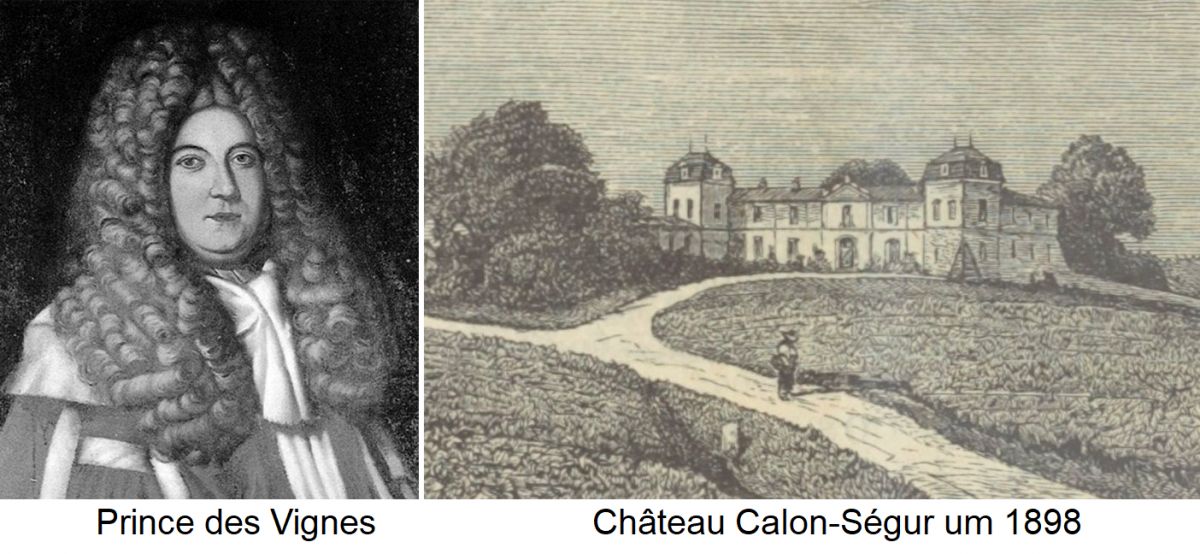The famous French aristocratic family exerted a decisive influence on wine growing in Bordeaux. The first in the long line was the notary Jacques de Ségur (+1691), a native of Pauillac, who held the position of councillor in the Parliament of Bordeaux. In 1670, his wife Jeanne de Gasq brought the seigneurie (manor house) Lafite as a dowry to the marriage, which then developed into the Premier Cru Classé vineyard Château Lafite-Rothschild. He subsequently expanded the vineyard holdings by planting new vines and purchasing additional vineyards until 1680. Among them was a plot called "Clos de Mouton", from which Château Mouton-Rothschild emerged. His son Alexandre de Ségur (1674-1716) married Marie-Thérèse de Clausel in 1695, who brought the Premier Cru Classé vineyard Château Latour, the entire southern part of Pauillac and another vineyard as a dowry.

Their son Marquis Nicolas-Alexandre de Ségur (1695-1755) became president of the parliament of Bordeaux (picture). Through his marriage in 1730 he came into possession of the Château Calon-Ségur. He also owned other vineyards in Médoc and Graves. Probably the most famous representative of the family thus called a true wine-growing empire his own. A total of three of the wineries then classified as Premiers Crus in the famous Bordeaux classification in 1855 were part of his property. However, the sizes and boundaries of the estates at that time did not exactly match those of today. The Marquis also recognized the quite different terroir of Lafite and Mouton, and made a separation. However, Calon remained his favourite estate with the traditional saying: "I produce wine on Lafite and Latour, but my heart is in Calon"
Thanks to improved viticultural techniques, the first successes were achieved from the 1720s onwards. Following the example of Arnaud III Pontac (1599-1682) of Château Haut-Brion, the marquis marketed the wines under the Château name, which was not a matter of course at the time. The wines were mainly exported to England. Through Marshal Richelieu (1696-1788) the Lafite wine later also reached the court of King Louis XV (1710-1774) and the Marquis became a welcome guest at court. One day, the king asked him about the magnificent gemstones that adorn his skirt as buttons. To general amazement, the marquis confessed that the supposed jewels were only carefully cut pebbles from his vineyards. Thereupon the king awarded him the title "Prince des Vignes" (prince of the vineyards).
The wine-growing income was considerable - the two wineries Château Lafite and Château Latour alone produced 100,000 Livres annually. After his death, the Marquis left a fortune of two million Livres, but no male heir. The extensive estate was divided between his four daughters and their children. Lafite and Latour, among others, were also separated at that time, although the property remained in the family and was looked after by the same administrator until 1785. Comte Marie-Alexandre-Nicolas de Ségur, the son of the eldest daughter of the "Prince des Vignes", inherited Château Lafite. However, he was far less enterprising than his grandfather and, due to his passion for gambling, he slipped into financial problems. High gambling debts forced him to sell Château Lafite in 1784. It went to a relative, Nicolas Pierre de Pichard, first president of the parliament of Bordeaux. He was the last owner from the Ségur family. In 1794, during the turmoil of the French Revolution, he first lost his property and then, under the guillotine, his head.
There were then six more owners until the estate was sold at auction in 1868 to Baron James de Rothschild (1792-1868) of the French branch of the family and was now called Château Lafite-Rothschild. The Mouton part was sold by the Ségur family probably already around 1725 to a Baron Joseph de Brane and finally came in 1853 into the possession of Baron Nathaniel de Rothschild (1812-1870) of the English family branch. This called it now Château Mouton-Rothschild. Two other estates of the family were sold in 1810 and united by the new owner under the name Château Phélan-Ségur. Château Latour was the last vineyard to remain in the ownership of the Ségur family until 1963. However, descendants of the family still sit on the board of directors of the company "Société Civile du Vignoble de Château Latour".
Nicolas-Alexandre de Ségur: Public Domain, Link
Château Calon-Ségur: from Eugène Vergez, Domain public, Link
Voices of our members

For me, Lexicon from wein.plus is the most comprehensive and best source of information about wine currently available.
Egon Mark
Diplom-Sommelier, Weinakademiker und Weinberater, Volders (Österreich)